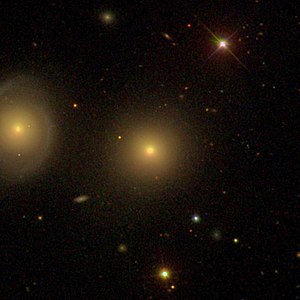NGC 7778
| Galaxy NGC 7778 |
|
|---|---|

|
|
| NGC 7779 & NGC 7778, SDSS image | |
| AladinLite | |
| Constellation | fishes |
|
Position equinox : J2000.0 , epoch : J2000.0 |
|
| Right ascension | 23 h 53 m 19.7 s |
| declination | + 07 ° 52 ′ 15 ″ |
| Appearance | |
| Morphological type | E. |
| Brightness (visual) | 12.7 mag |
| Brightness (B-band) | 13.7 mag |
| Angular expansion | 1.0 '× 1.0' |
| Surface brightness | 12.7 mag / arcmin² |
| Physical data | |
| Redshift | 0.017405 ± 0.000023 |
| Radial velocity | 5218 ± 7 km / s |
|
Stroke distance v rad / H 0 |
(239 ± 17) · 10 6 ly (73.3 ± 5.1) Mpc |
| history | |
| discovery | William Herschel |
| Discovery date | November 12, 1784 |
| Catalog names | |
| NGC 7778 • UGC 12827 • PGC 72756 • CGCG 407-069 • MCG + 01-60-043 • 2MASX J23531967 + 0752152 • GC 5025 • H III 231 • h 2278 • GALEX ASC J235319.78 + 075217.3 • LDCE 1600 NED001 | |
NGC 7778 is an elliptical galaxy from the Hubble type E0 in the constellation fish on the ecliptic . It is estimated to be 239 million light years away from the Milky Way and has a diameter of around 70,000 ly.
In the same area of the sky are the galaxies NGC 7779 , NGC 7780 , NGC 7781 , NGC 7782 .
The object was discovered by Wilhelm Herschel on November 12, 1784 .
